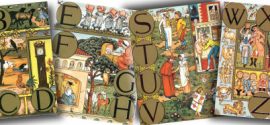Reading-Related Skills
Adapted from Overcoming Dyslexia by Dr. Sally Shaywitz
Early Preschool Accomplishments (age 3-4)
- Begins to develop awareness that sentences, and then words, come apart
- Shows an interest in the sounds of language: repeats and plays with sounds, especially rhymes
- Identifies ten alphabet letters, most likely from his or her own name
Late Preschool Accomplishments (age 4-5)
- Breaks spoken words into syllables (such as today=to-day)
- Begins to sound out words, sees that each letter has a different sound
- Recognizes and names a growing number of letters
Beginning Kindergarten Accomplishments (age 5-5½)
- Compares whether two spoken words rhyme:
Do cat and hat rhyme? Do hop and mat rhyme? - Names a word that rhymes with a simple word like cat or make
- Recognizes and names just about all upper- and lower-case letters
End of Kindergarten Accomplishments (age 5½-6)
- Continues to progress in breaking spoken words apart
- Identifies which of three spoken words or pictures begins with the same first sound of a given word–given the word “car,” the child can select the word with the same beginning sound in this grouping: dog, cat, mat
- Can pronounce the beginning sound in a word
- Names all the letters of the alphabet
- Begins to decode simple words
- Recognizes a growing number of common words by sight
(you, my, the) - Uses inventive spelling to write words
- Writes his or her own name (first and last) and the names of family members and/or pets
First Grade Accomplishments (age 6-7)
- Can say the word that remains if given sound is taken away from the beginning or end of a word—when asked to say “bat” without the “b,” she says “at”
- Blends the sounds in three-phoneme words—when asked, “what do the sounds m, aaaa, and n form?”, answers man
- Reads aloud with accuracy and comprehension any text that is meant for first grade
- Links letters to sounds to decode unknown words
- Recognizes by sight common irregularly spelled words, which do not follow the pattern of a word family, such as have, said, where, two
Second Grade Accomplishments (age 7-8)
- Begins to learn strategies for breaking multisyllabic words into syllables
- Accurately reads some multisyllable real and nonsense words, such as Kalamazoo
- Reads and comprehends fiction and nonfiction meant for second grade
- Begins to read with fluency–reads accurately, smoothly, rapidly, and with inflection
- Represents the complete sound of a word when spelling
- Reads on his own voluntarily
Third Grade Accomplishments (age 8-9)
- Uses knowledge of prefixes, suffixes, and roots to infer meaning of words
- Reads longer fiction selections and chapter books
- Summarizes the main points from readings
- Correctly spells previously studied words
- Uses a dictionary to learn the meaning of unknown words
Fourth Grade and Above Accomplishments (age 9)
- Reads to learn
- Reads for pleasure and for information
Related
Suspect Dyslexia? Act Early
Early intervention and screenings for dyslexia help students get the positive support earlier.

The A to Z of Teaching Beginning Reading
To break the reading code, your child must solve the two parts of the reading puzzle: one involving spoken language, and the other involving written language.
Read MoreDeveloping a Foundation for Reading
Early good practices enrich learning and develop a foundation for later reading. Try these reading-readiness steps to engage your child.
Read More